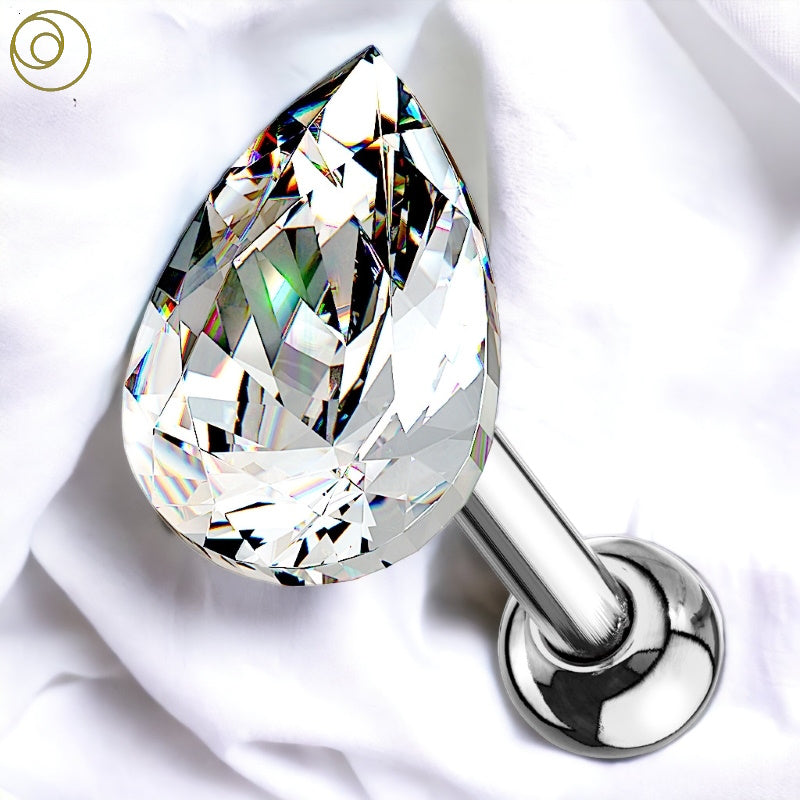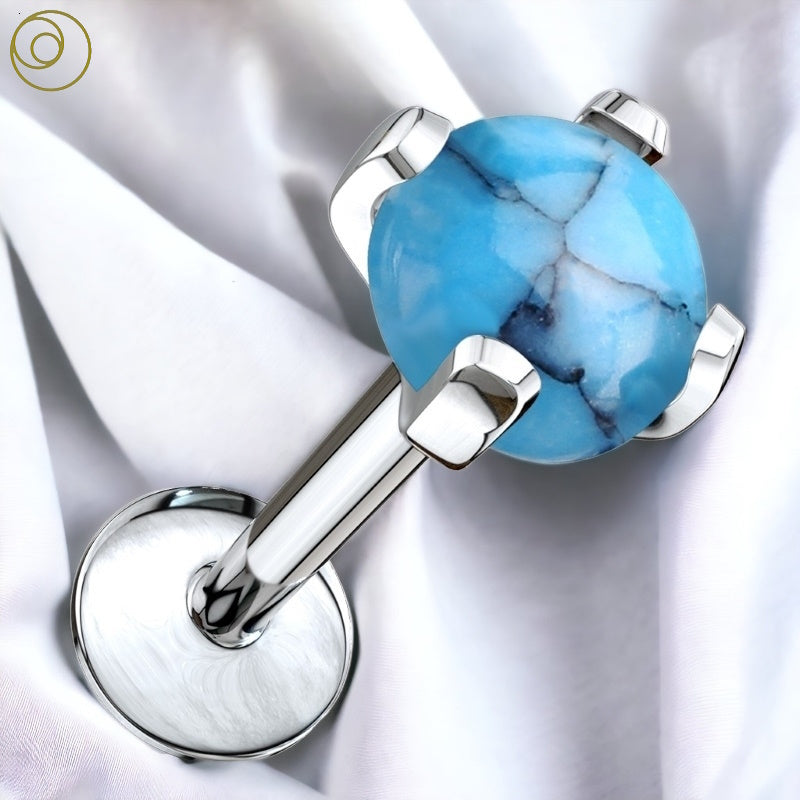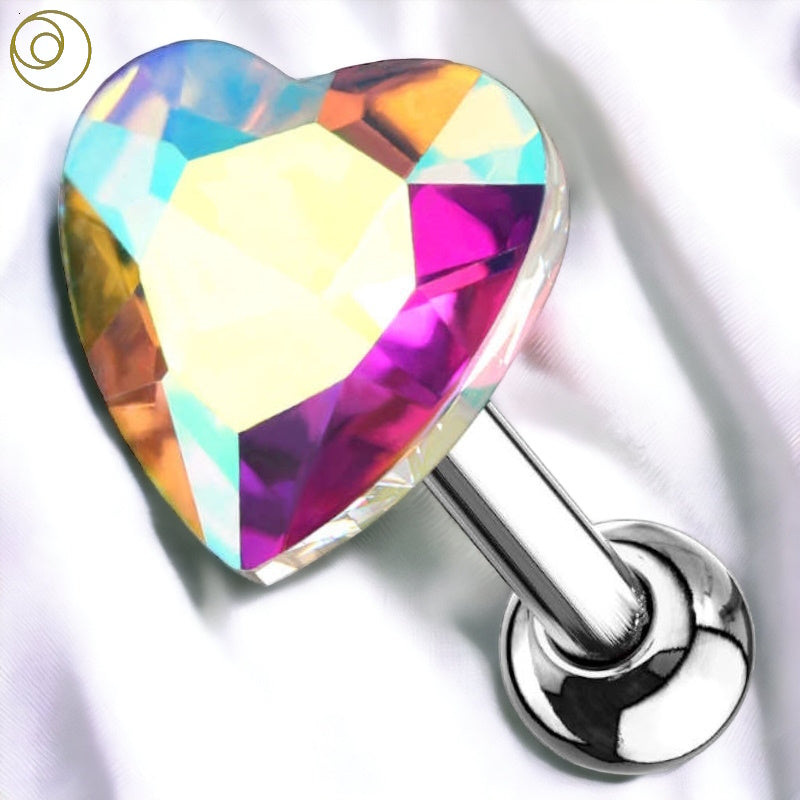
Tragus Piercing Guide: Nuts And Bolts Of The Tragus
Share
Tragus Piercing Article Quick Reference:
History | Myths | Complications | Pain | Cost | Procedure | Healing | Aftercare | Jewelry | Celebrities
Related Articles & Jewelry:
Tragus Earrings | Labret Jewelry | Cartilage Rings
The tragus is situated on the outer part of the ear, directly in front of the ear canal. It is a small, protruding piece of cartilage that covers the entrance to the ear canal. To locate it, place your finger on the side of your face just above your earlobe. After that, move it upwards until you feel a small, round projection. This is the tragus, the area where the piercing will be performed.
For an easier visual, check out the diagram below showing the exact location.

ANCIENT TRAGUS PIERCING HISTORY
The tragus ear piercing has a fascinating history that stretches back through the centuries. The practice of piercing the tragus can be traced to ancient times and various cultures worldwide. In some societies, tragus piercings held symbolic significance. The people belived that the tragus could enhance hearing or provide protection against evil spirits. These piercings were functional also served as a form of self-expression and cultural identity.
As time passed, tragus piercings began to gain popularity beyond their traditional and cultural contexts. During the 1970s and 1980s, the punk and alternative scenes embraced tragus piercings as a rebellious and edgy fashion statement. They became associated with non-conformity and a desire to break away from conventional norms. This period played a crucial role in bringing tragus piercings into the mainstream consciousness.
In recent years, tragus piercings have become increasingly popular and are now embraced by a wide range of individuals. A desire for uniqueness and edginess, along with many jewelry options, has made them widely accepted. Today, people see tragus piercings as a fashionable trend to express personal style. They captivate with either delicate studs or bold hoops, serving as self-expression in modern fashion.
THOSE CRAZY TRAGUS PIERCING MYTHS
Indeed, there are several misconceptions surrounding tragus piercings that have led to misunderstandings and concerns. Let's set the record straight and debunk some of those tragus piercing myths floating around. Check out several of these myths below:
- Tragus Piercings Cause Hearing Loss: A common myth suggests a loss of hearing with the tragus piercing. However, the piercing, performed on the outer part of the ear, does not affect hearing.
- The Tragus Cannot Be Pierced Due To Its Location: Although small, professional piercers possess the expertise to perform tragus piercings safely and accurately.
- Tragus Piercings Are Extremely Painful: Pain thresholds vary from person to person, but people generally consider tragus piercings to be moderately painful. Proper aftercare should reduce any discomfort within a few days.
- Tragus Piercings Take A Long Time To Heal: Although tragus piercings require careful aftercare, they typically heal within 6 to 12 weeks, which is similar to other ear cartilage piercings.
So there you have it, folks. Don't let these myths scare you away from the fabulous world of tragus piercings. Embrace the facts, seek professional guidance, and rock that stylish ear bling with confidence!

POPULARITY OF THE TRAGUS BY AGE AND GENDER
Young adults and individuals in their twenties predominantly favor tragus piercings, often drawn to their versatility and aesthetic appeal.
The age requirement for getting a tragus piercing varies depending on local regulations and individual piercer policies. Furthermore, in many jurisdictions, minors under the age of 18 may need parental consent or a legal guardian present during the procedure. Authorities implement these rules to ensure young individuals' well-being and informed decision-making regarding body modifications. Always check local regulations and consult with a professional piercer to understand specific age requirements and consent procedures in your area before considering a tragus piercing.
THE RISKS OF A TRAGUS PIERCING
When considering a tragus ear piercing, it is essential to be aware of potential risks and complications associated with the procedure. Now, I know what you're thinking, "Why rain on my piercing parade?" But trust me, my friend, knowledge is power, and it's all about having a safe and successful piercing experience. See some of these complications below:
- Infection: Like any piercing, the tragus is susceptible to infection. Therefore, proper aftercare, such as cleaning the piercing with a saline solution, can help reduce the risk.
- Allergic Reactions: Some individuals may experience allergic reactions to certain metals used in jewelry. Opting for hypoallergenic materials like titanium or surgical steel can mitigate this risk.
- Keloids: Keloid formation, which is the overgrowth of scar tissue, is possible with tragus piercings. People prone to keloids should carefully consider the potential risks.
- Migration And Rejection: In rare cases, the body may reject the piercing, causing it to migrate or completely push out the jewelry. Choosing an experience piercer and the proper jewelry minimizes the risk.
While tragus piercings offer a unique and stylish way to express personal style, it is important to acknowledge the potential risks involved.
NOW FOR THE COMPLICATIONS?
Before considering a tragus piercing, it is crucial to also take into account certain health conditions that may warrant caution and consultation with a professional piercer or healthcare provider. See a few of these below:
- Blood Clotting Disorders Or The Use Of Blood Thinners: Individuals with blood clotting disorders or those who take blood thinners should exercise caution before getting a tragus piercing. These conditions can increase the risk of bleeding during the piercing process and may affect the healing process.
- Diabetes: People with diabetes should approach tragus piercings with care. Diabetes can affect the body's healing process and increase the risk of infections. It is advisable to consult with a healthcare provider to assess the individual's specific situation and determine if a tragus piercing is suitable.
- Skin Conditions On The Ear Area: Skin conditions like eczema or psoriasis can make the area around the tragus more sensitive and prone to irritation or inflammation. You should discuss the condition with a professional piercer or healthcare provider to evaluate if getting a tragus piercing is advisable or if you should take any additional precautions.
- Immune System Disorders: Individuals with immune system disorders may have a compromised ability to heal, making piercings more susceptible to complications. It is important to consult with a healthcare provider to assess the risks and benefits of a tragus in such cases.

WANT TO SAY BYE TO YOUR TRAGUS?
Reversing a tragus ear piercing is a straightforward process that can be done without professional assistance beginning by removing the jewelry. The removal process usually involves carefully unscrewing the ball or closure on the jewelry, allowing it to slide out of the piercing. It is important to handle the jewelry and piercing area with clean hands to minimize the risk of infection.
After successfully removing the tragus jewelry, you should thoroughly clean and properly care for the area to promote healing. Following any aftercare instructions from the professional piercer or healthcare provider is crucial to ensure proper healing of the piercing site and avoid any potential complications.
A PAIN IN THE TRAGUS
The pain experienced during a tragus piercing can vary from person to person. While it is considered moderately painful, there are ways to manage discomfort:
- Numbing Cream: Some individuals choose to apply a numbing cream to the tragus area before the piercing to reduce pain.
- Deep Breathing And Relaxation Techniques: Focusing on deep breaths and using relaxation techniques can help distract from the pain and promote a sense of calm.
- Over-The-Counter Pain Relievers: Taking over-the-counter pain relievers, such as acetaminophen or ibuprofen, can help alleviate discomfort following the piercing.
WILL IT BE CHEAP OR EXPENSIVE?
The cost of a tragus piercing can vary depending on the region and the reputation of the piercing studio. Check out the estimates below:
- Midwest: In the Midwest region, such as cities like Chicago, IL, Minneapolis, MN, and St. Louis, MO, the estimated cost range typically falls between $30 and $50.
- South: Moving to the South, cities like Atlanta, GA, Dallas, TX, and Miami, FL, the cost range tends to be slightly higher, ranging from $40 to $60.
- East Coast: On the East Coast, which includes cities like New York, NY, Boston, MA, and Washington, D.C., the cost range for a tragus piercing tends to be higher, ranging from $50 to $80.
- West Coast: Finally, on the West Coast, in cities like Los Angeles, CA, San Francisco, CA, and Seattle, WA, the cost range is generally higher, ranging from $60 to $100.
When it comes to these costs, we're in the wild and wacky world of estimates. These numbers are like sneaky little creatures that can change faster than the latest fashion trends. So buckle up, my budget-savvy pals, because factors like the piercing studio, the piercer's expertise, the bling quality, and even those fancy extra services can twist and turn the price rollercoaster. Do your homework! Research those studios, read those reviews, and don't be afraid to ask about the costs and what magical services they'll be showering you with. After all, we're talking about your tragus, your style, and your hard-earned coinage.
THE TRAGUS PIERCING PROCEDURE
First of all, the gauge of the needle used for a tragus piercing typically ranges from 16 to 18 gauge. The specific gauge size can depend on factors such as the individual's anatomy, the preference of the piercer, and the type of jewelry being inserted.
Check out this general set of steps involved in a tragus piercing:
- Consultation: This is an important opportunity for the piercer to discuss the procedure with the individual. They'll address any concerns or questions, and assess their suitability for the piercing.
- Preparation: This involves cleaning and sterilizing the tragus area to create a hygienic environment for the piercing. Proper sterilization techniques are crucial to minimize the risk of infections and ensure the safety of the individual.
- Marking The Spot: This step is crucial in achieving accurate placement and symmetry. A pen or marker is used to mark the location. This allows the piercer to ensure proper alignment before proceeding with the piercing itself.
- Piercing: Using a sterilized needle the piercer performs the actual piercing. The process is typically quick and precise, with the piercer aiming to minimize discomfort and promote proper healing.
- Inserting Jewelry: Once the piercing is complete, the chosen jewelry is carefully inserted into the fresh hole.
- Aftercare Instructions: Proper aftercare is crucial for the healing process and helps minimize the risk of complications. The individual will receive guidance on cleaning the piercing. Also suggestions on avoiding irritants, and monitoring for any signs of infection or other issues.
By understanding these steps, individuals can approach the tragus piercing process with confidence and enjoy their new piercing.
TRAGUS HEALING TIME
The healing time for a tragus piercing can vary from person to person, but it typically ranges from 6 to 12 weeks. During this period, it is important to follow proper aftercare guidelines to promote healing and prevent complications. The initial healing stage, which usually lasts around 4 to 8 weeks, involves the formation of a fistula, a tunnel of scar tissue that keeps the piercing stable. After the initial healing, the fistula continues to strengthen and mature over the following weeks, leading to a fully healed tragus piercing.
Keep in mind that factors such as overall health, immune response, aftercare practices, and potential complications can influence individual healing times. If you experience prolonged pain, swelling, redness, or any signs of infection, it is advisable to consult a professional piercer or healthcare provider for appropriate guidance and evaluation.
AFTERCARE FOR THE TRAGUS PIERCING
Proper aftercare is crucial for the healing and maintenance of a tragus piercing. Following specific guidelines and taking precautions can help minimize the risk of infection, irritation, and complications. By implementing these aftercare practices, individuals can support the healing process and ensure the long-term health and well-being of their tragus piercing.
- Cleaning: To care for a tragus piercing, it is recommended to clean the piercing twice a day using a saline solution or mild saline-based piercing aftercare product. This helps to keep the piercing clean and free from bacteria, promoting proper healing.
- No Touching: It is important to avoid touching the piercing with dirty hands, as this can introduce harmful bacteria and increase the risk of infection. Regular hand washing before handling the piercing is essential.
- Avoid Bodies Of Water: Avoid swimming in pools, hot tubs, or bodies of water. These environments can harbor bacteria and increase the risk of infection.
- Sleeping: Avoid sleeping on the pierced side to prevent irritation and pressure on the healing piercing.
- Irritants: Avoid using harsh chemicals or beauty products near the piercing. This includes hairspray, perfumes, makeup, or any products that may come into direct contact with the piercing. These substances can interfere with the healing process and cause discomfort or irritation.
Proper aftercare practices are essential for the well-being of a tragus piercing. By following these aftercare guidelines, individuals can support the healing process and maintain a healthy tragus piercing.
CHANGING OUT THE BLING
I know you're eager to swap out that jewelry and show off your dazzling tragus bling, but hold onto your piercing dreams for a hot minute! We've got a crucial rule here: wait for that tragus piercing to fully heal before diving into the jewelry box. Now, I know waiting can be harder than resisting a sale at your favorite shoe store, but trust me, it's worth it. When changing the jewelry for the first time, follow these safety tips:
- Clean The New Jewelry: Make sure you have properly cleaned the new jewelry and the area around the piercing before inserting it.
- Wash Your Hands: Handle the jewelry with clean hands to avoid introducing bacteria.
- Jewelry Insertion: Gently insert the new jewelry, taking care not to force it or cause unnecessary discomfort.
TRAGUS PIERCING JEWELRY MATERIALS
Choosing the right jewelry material is crucial for the health, comfort, and overall success of a tragus piercing. The type of material used should be hypoallergenic, biocompatible, and suitable for initial healing and long-term wear. See some examples of these materials below:
- Implant-Grade Titanium: Implant-grade titanium is a highly recommended material for tragus piercing jewelry. It is hypoallergenic, lightweight, and biocompatible, reducing the risk of allergic reactions and promoting proper healing.
- Surgical Steel: Surgical steel is another commonly used material for tragus piercings. It is durable, affordable, and typically well-tolerated by most individuals. However, some people with sensitivities may still experience allergic reactions, so caution is advised.
- Niobium: As a hypoallergenic metal, manufacturers often use niobium in piercings for its biocompatibility, making it an excellent choice for individuals with metal sensitivities.
- BioPlast Or PTFE (Polytetrafluoroethylene): BioPlast or PTFE are flexible, biocompatible materials that are suitable for initial healing stages. They reduce pressure and friction on the piercing, providing comfort during the healing process.
- 14K Or 18K Gold: Once the piercing has fully healed, individuals may choose 14K or 18K gold jewelry. This adds elegance to the piercing.
TRAGUS JEWELRY DESIGNS
The choice of jewelry for your tragus is an exciting opportunity to personalize the piercing and make a style statement. See the following types:
- Firstly, Studs: Simple studs with decorative ends are popular choices for tragus piercings. They come in various designs, including gemstones, flat disks, or small charms, allowing for versatility and customization.
- Secondly, Labrets: Labret jewelry offers a combination of style, comfort, and functionality. With its customizable tops and secure barbell design, labret jewelry is a popular choice.
- Finally, Captive Bead Rings: CBR's can create a bold and stylish look in a tragus piercing. They come in different sizes and designs, from small and dainty to larger, more eye-catching options.
Ultimately, individuals should make the choice of jewelry style and material in consultation with a professional piercer, considering individual preferences, healing requirements, and any potential sensitivities or allergies.
CELEBRITIES SEEN WITH A TRAGUS
Tragus piercings have become a popular trend embraced by many, including celebrities who use these stylish adornments to enhance their looks and make a bold fashion statement. Celebrities from various fields, including music, film, and fashion, have been seen sporting tragus piercings, adding a touch of edge and individuality to their overall appearances. See some trendsetters below:
- Cara Delevingne: The model and actress embrace a tragus piercing, enhancing her avant-garde and fashion-forward persona.
- Jaden Smith: The actor and musician is known for his unique style, which often includes a tragus piercing.
- Vanessa Hudgens: The actress and singer has been seen wearing a tragus piercing, adding an edgy flair to her bohemian aesthetic.
- Zoe Saldana: The actress shows off a tragus piercing, bringing a touch of sophistication to her red-carpet looks.
- Bella Thorne: The actress and social media personality embrace a tragus piercing, reflecting her vibrant and bold fashion choices.
- Zayn Malik: The musician and former One Direction member showcases a tragus piercing, complementing his distinctive and modern style.
From famous musicians to renowned actors, these celebrities have contributed to the growing popularity and widespread acceptance of tragus piercings as a fashionable and chic accessory.
CONVINCED YET?
Tragus ear piercing offers a stylish and unique way to express yourself. Understanding the location, history, popularity, risks, aftercare, and various aspects of this piercing is crucial before undergoing the procedure. By following proper aftercare practices, choosing high-quality jewelry, and consulting with a professional piercer, you can enjoy a safe and fashionable tragus piercing that enhances your personal style.
Need to find a piercer? Check out the Association of Professional Piercers.
AUTHOR: SCOTT S.



